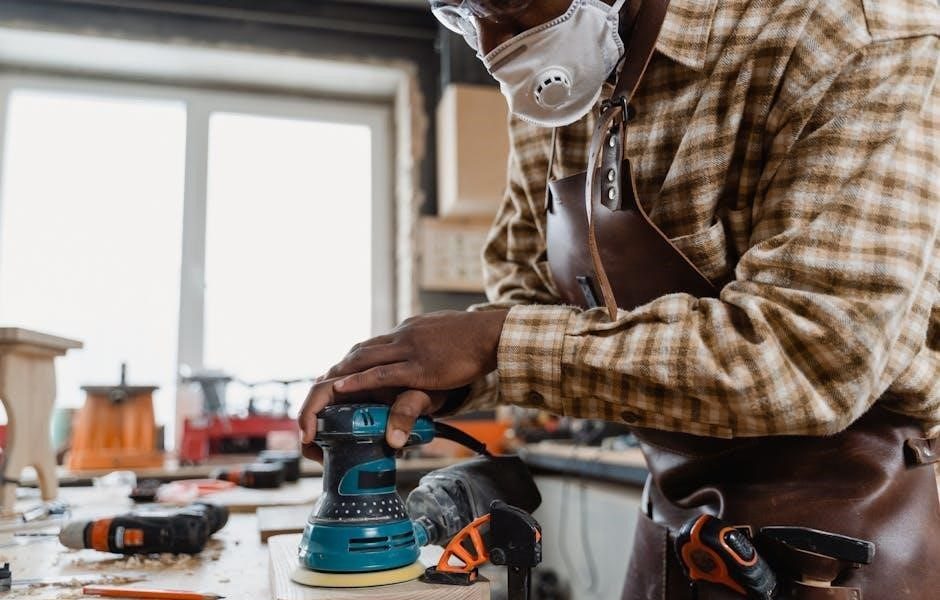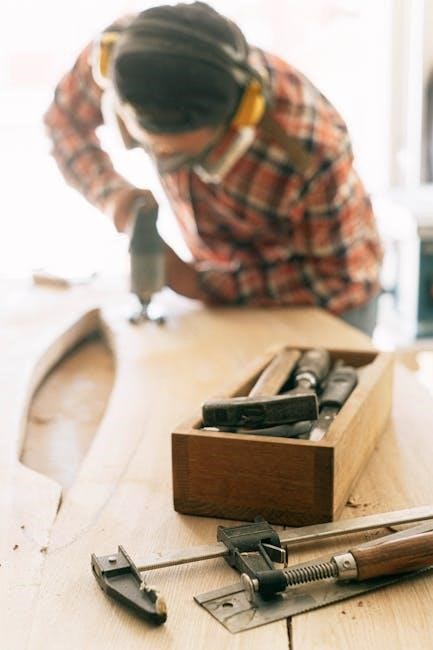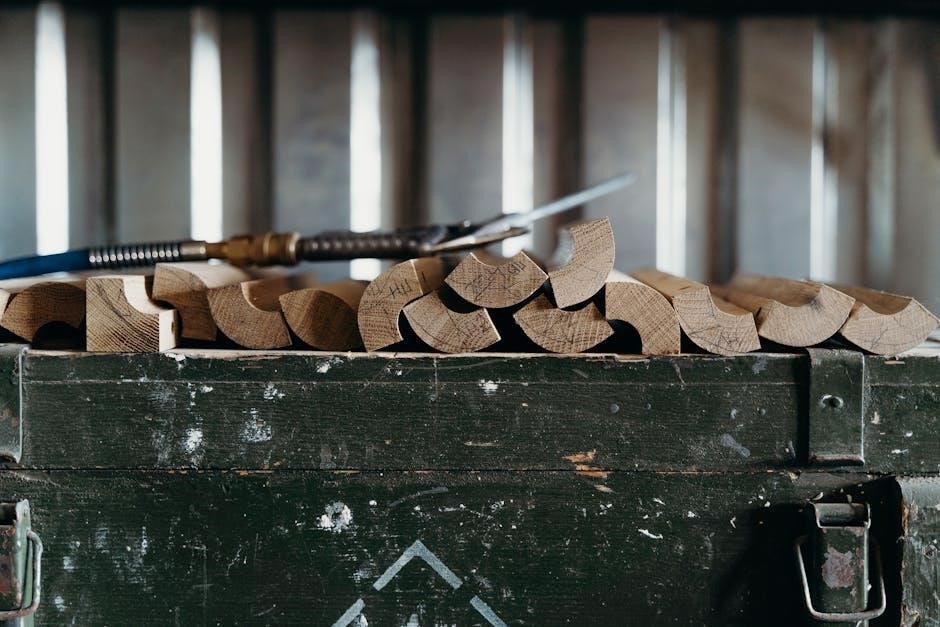
edge clamp saw guide
An edge clamp saw guide is a precise tool designed to enhance accuracy and stability during cutting tasks, ensuring straight and consistent results in woodworking projects․
1․1 What is an Edge Clamp Saw Guide?
An edge clamp saw guide is a tool designed to enhance cutting accuracy by clamping onto the workpiece edge and guiding the saw along a straight path, ensuring precise and consistent cuts․ It typically features a clamping mechanism to secure it in place and a guide system, such as a fence, to align the saw blade․ Made from durable materials like metal or high-grade plastic, it is versatile for various saw types and projects requiring straight cuts․ The guide often includes adjustable features for different blade widths and may have additional conveniences like measuring scales․ Its design emphasizes efficiency, safety, and high-quality finishes, making it a valuable asset for woodworking tasks․
1․2 Importance of Using an Edge Clamp Saw Guide
Using an edge clamp saw guide is essential for achieving precision and consistency in woodworking projects․ It minimizes errors and ensures straight cuts, saving time and materials․ The guide enhances safety by maintaining blade stability, reducing the risk of accidents․ Its ability to maintain consistent alignment boosts efficiency, allowing for faster project completion․ Additionally, it helps prevent costly mistakes, making it a crucial tool for professionals and DIYers alike․ Overall, an edge clamp saw guide is a simple yet effective solution for improving accuracy and productivity in various cutting tasks․

How Edge Clamp Saw Guides Work
Edge clamp saw guides function by securely clamping to the edge of a workpiece, providing a stable reference for the saw blade to follow, ensuring straight cuts․
2․1 Basic Mechanism of Edge Clamp Saw Guides
An edge clamp saw guide operates by attaching securely to the edge of a workpiece, utilizing adjustable clamps to hold the guide in place․ The mechanism ensures alignment between the saw blade and the desired cut line, promoting accuracy․ The guide typically features a rigid frame and a clamping system that applies even pressure, preventing movement during cutting․ This setup allows for consistent, straight cuts by serving as a stable reference point, reducing the risk of human error․ The design emphasizes ease of use and adaptability across various materials and saw types․
2․2 Role of Clamping Mechanisms
The clamping mechanisms in edge clamp saw guides play a vital role in securing the guide to the workpiece․ These mechanisms ensure a firm, even grip, preventing any movement during cutting․ By maintaining stability, they enhance precision and reduce the risk of inaccuracies․ The clamps are typically adjustable, allowing them to accommodate various material thicknesses and types․ This secure hold is essential for achieving consistent results and protecting the workpiece from damage․ The clamping system is a cornerstone of the guide’s functionality, enabling precise control and safe operation during sawing tasks․
2․3 Alignment Features for Precision Cutting
Alignment features in edge clamp saw guides are designed to ensure precise cutting by maintaining accurate alignment between the saw blade and the workpiece․ These features often include adjustable fences, laser guides, or marked measurement scales that help users set exact cutting angles and distances․ By aligning the guide with the material’s edge, users can achieve straight, consistent cuts with minimal effort․ These features are especially beneficial for intricate projects, as they reduce the likelihood of human error․ Proper alignment ensures professional-quality results and enhances overall cutting efficiency and safety․

Types of Edge Clamp Saw Guides
Edge clamp saw guides come in standard, adjustable, and precision types, catering to different needs and ensuring accurate cuts for various woodworking projects and materials․
3․1 Standard Edge Clamp Saw Guides
Standard edge clamp saw guides are the most basic type, designed for straightforward cutting tasks․ They feature a fixed design with minimal adjustments, making them easy to use and durable․ These guides are ideal for general woodworking projects where precise, repetitive cuts are needed․ They typically include a rigid clamp and a simple alignment system, ensuring stability and accuracy․ While they lack advanced features, standard guides are cost-effective and reliable for everyday use, making them a popular choice for DIY enthusiasts and professionals alike․
3․2 Adjustable Edge Clamp Saw Guides
Adjustable edge clamp saw guides offer enhanced versatility for various cutting tasks․ They feature customizable settings, such as tension, angle, and alignment adjustments, allowing users to tailor the guide to specific projects․ These guides are ideal for working with different materials and thicknesses, providing precise control․ Many models include quick-release mechanisms and adjustable stops for efficient operation․ Their adaptability makes them a favorite among professionals and serious DIYers, ensuring accurate and consistent results across diverse applications․
3․3 Precision Edge Clamp Saw Guides
Precision edge clamp saw guides are designed for high-accuracy cutting tasks, offering superior alignment and stability․ These guides often feature advanced adjustment systems, such as micro-positioning knobs and laser-aligned calibration․ Built with high-grade materials like steel or aluminum, they ensure durability and resistance to wear․ Their non-slip surfaces and tight clamping mechanisms minimize material movement during cuts․ Ideal for professional woodworkers and craftsmen, precision guides deliver exacting results, making them indispensable for intricate projects or large-scale production environments where consistency is critical․

Choosing the Right Edge Clamp Saw Guide
Choosing the right edge clamp saw guide involves assessing your project needs, material types, tool compatibility, and build quality․ Consider features like adjustability, alignment aids, and durability to ensure optimal performance for your woodworking tasks․
4․1 Factors to Consider When Selecting an Edge Clamp Saw Guide
When selecting an edge clamp saw guide, consider project requirements, material thickness, tool compatibility, and durability․ Evaluate the guide’s adjustability to accommodate different blade widths and cutting angles․ Check alignment features like scales or stops for precision․ Assess the clamping force to ensure it holds the material securely without causing damage․ Consider the ease of setup and portability for workshop or job site use․ Additionally, review user reviews and manufacturer specifications to ensure the guide meets your specific woodworking or metalworking needs effectively․
4․2 Material and Build Quality
Material and build quality are crucial for the durability and performance of an edge clamp saw guide․ High-grade steel or aluminum alloys are preferred for their strength and resistance to wear․ Look for robust construction with minimal flex to maintain accuracy․ Durable coatings or finishes can protect against corrosion․ Additionally, components like hardened steel clamps or precision-machined parts ensure long-term reliability․ A well-built guide withstands frequent use and harsh workshop conditions, providing consistent results over time․
4․3 Size and Compatibility
Choosing the right size and ensuring compatibility with your saw and materials are essential․ The guide must fit your saw model and accommodate the thickness of your workpieces․ Compatibility varies, as not all guides work with every saw type․ Check the product specifications to ensure it matches your equipment․ Adjustable models offer versatility for different material widths․ Proper fit ensures smooth operation and accurate cuts․ Always verify dimensions and compatibility before purchasing to avoid installation issues․ A well-matched guide enhances performance and safety․
4․4 Additional Features for Enhanced Functionality
Modern edge clamp saw guides often include features that boost efficiency and convenience․ Adjustable stops allow for precise repeat cuts, while micro-adjustments ensure fine-tuned accuracy․ Some models feature a quick-release mechanism for easy setup and removal․ Anti-vibration pads improve stability, reducing chatter during cuts․ Built-in measuring scales or rulers add convenience for quick alignments․ Dust-collection ports help maintain a clean workspace․ Ergonomic designs enhance comfort during prolonged use․ These extras cater to specific needs, offering tailored solutions for various woodworking projects․ Prioritize features that align with your workflow for optimal results․

How to Install and Set Up an Edge Clamp Saw Guide
Attach the guide to your saw, ensuring proper alignment and squaring with the blade․ Tighten clamps securely, then test accuracy with scrap material․
5․1 Step-by-Step Installation Process
To install an edge clamp saw guide, start by attaching it to your saw’s fence or table․ Align the guide with the blade, ensuring it’s square․ Clamp the guide firmly and tighten all screws․ Next, test the alignment by making a small cut on scrap material; Adjust the guide as needed for accuracy․ Finally, secure the clamp tightly and ensure it’s level for stable operation․ Always refer to the manufacturer’s instructions for specific installation details․
5․2 Calibration and Adjustment Tips
Calibrate your edge clamp saw guide by aligning it with the saw blade for precise cuts․ Use shims to fine-tune the alignment if necessary․ Adjust the guide’s position to ensure it’s parallel to the blade for straight cuts․ Tighten the clamping mechanism evenly to avoid uneven pressure․ Test the setup with a scrap piece of material to verify accuracy․ Make adjustments as needed for optimal performance․ Always ensure the guide is level and securely fastened before use․
5․3 Securing the Guide for Stable Operation
To ensure stable operation, install the edge clamp saw guide on a flat, clean surface․ Use the provided hardware to tighten the guide firmly, avoiding over-tightening․ Ensure the guide is level and evenly balanced for consistent performance․ Check for any loose connections and secure them properly․ Regularly inspect the mounting points for wear or damage․ A stable setup prevents vibrations and ensures accurate cuts․ Always follow the manufacturer’s instructions for securing the guide to maintain reliability and safety during use․

Using the Edge Clamp Saw Guide Safely
Always wear safety glasses and gloves․ Keep loose clothing tied back․ Avoid overreaching and maintain a firm stance․ Ensure the workpiece is secure before cutting․ Plan cuts carefully to minimize mistakes․ Keep children and pets away from the workspace․
6․1 Safety Precautions Before Use
Before using an edge clamp saw guide, inspect the tool for any damage or wear․ Wear safety glasses, gloves, and a dust mask to protect against debris․ Ensure the workpiece is securely clamped to prevent movement․ Keep the work area clean and free from obstructions․ Double-check the alignment of the guide and saw blade for accuracy․ Avoid wearing loose clothing that could get caught in the saw․ Always read the manufacturer’s instructions and ensure proper setup before starting any project․ Keep bystanders at a safe distance to minimize risks․
6․2 Best Practices for Operation
Always maintain proper alignment between the saw blade and the edge clamp guide to ensure straight cuts․ Use consistent, steady feed rates to avoid uneven pressure, which can cause deflection․ Apply even clamping force to prevent the material from shifting during operation․ Keep the saw blade well-lubricated to reduce friction and heat buildup․ Regularly check the guide’s alignment and tighten any loose components before use․ Avoid applying excessive force, as this can damage the guide or the saw․ Monitor for wear on the clamp pads and replace them if necessary to maintain grip stability․
6․3 Handling Common Hazards
Common hazards when using an edge clamp saw guide include saw kickback, uneven cuts, and material movement during operation․ To mitigate these risks, ensure the guide is securely clamped and aligned before cutting․ Always maintain a firm grip on the saw and keep loose clothing tied back․ In case of kickback, stop the saw immediately and reposition the material․ Regularly inspect the guide for wear and tear, as damaged components can lead to inconsistent performance and increased danger․ Always keep bystanders at a safe distance and be prepared for unexpected movements․

Maintenance and Care of Edge Clamp Saw Guides
Regular maintenance ensures optimal performance and longevity․ Clean the guide after use, lubricate moving parts, and store it in a dry, protected area to prevent rust and damage․
7․1 Cleaning and Lubrication
Regular cleaning and lubrication are essential to maintain the performance of edge clamp saw guides․ Use a soft cloth to wipe away dust, debris, and sawdust․ For tougher residue, a mild solvent or alcohol can be applied․ Lubricate moving parts with silicone spray or grease to ensure smooth operation․ Avoid using harsh chemicals that might damage the finish or materials․ Clean after each use and lubricate weekly to prevent rust and friction․ Proper maintenance ensures accuracy, reduces wear, and extends the lifespan of the guide․
- Clean after each use with a soft cloth․
- Apply mild solvents for stubborn residue․
- Lubricate moving parts weekly․
- Use silicone spray or grease․
- Avoid harsh chemicals․
7․2 Storage and Protection
Proper storage and protection are crucial to preserve the functionality and longevity of edge clamp saw guides․ Store the guide in a dry, clean environment away from direct sunlight and moisture․ Use a protective case or cover to shield it from dust and accidental damage․ Avoid exposing the guide to extreme temperatures or humidity, as this can affect its alignment and material integrity․ Regularly inspect the storage area to ensure no pests or contaminants are present․ By storing your edge clamp saw guide correctly, you maintain its precision and readiness for future projects․
- Store in a dry, clean environment․
- Use a protective case or cover․
- Avoid direct sunlight and moisture․
- Keep away from extreme temperatures․
- Inspect storage area regularly․
7․3 Regular Inspection for Wear and Tear
Regular inspection is essential to identify and address wear and tear on edge clamp saw guides․ Check the clamping mechanisms for looseness or damage, and ensure alignment features are free from debris․ Inspect the guide rail for straightness and the clamp pads for excessive wear․ Lubricate moving parts periodically to maintain smooth operation․ Look for rust or corrosion, especially in humid environments․ Addressing issues early prevents downtime and ensures consistent cutting accuracy․ Schedule inspections after heavy use or exposure to harsh conditions to maintain optimal performance․
- Check clamping mechanisms for looseness or damage․
- Inspect alignment features for debris or misalignment․
- Examine guide rails for straightness and wear․
- Lubricate moving parts to ensure smooth operation․
- Look for rust or corrosion, especially in humid environments․

Troubleshooting Common Issues
Troubleshooting common issues with edge clamp saw guides involves identifying problems like misalignment, uneven clamping pressure, or worn components․ Regular inspections help prevent these issues․
- Misalignment causing uneven cuts․
- Clamp wear leading to loose holds․
- Damaged guide rails affecting accuracy․
8․1 Identifying and Resolving Alignment Problems
Alignment issues with edge clamp saw guides can lead to uneven cuts or drift during operation․ Signs include mismatched edges, uneven cuts, or blade drift․ To resolve, check guide parallelism to the blade․ Loosen adjustment screws, realign, and tighten․ Use shims for fine adjustments․ Ensure the fence is square to the table․ Regularly inspect and clean the guide rails to prevent debris-induced misalignment․ Calibration tools or gauges can help achieve precise alignment․ Addressing alignment problems promptly ensures accurate cuts and extends tool longevity․
8․2 Fixing Loose or Worn-out Clamp Components
Loose or worn clamp components can compromise the stability and accuracy of your edge clamp saw guide․ Inspect the clamping mechanism for wear or damage; Tighten any loose screws or bolts, and replace worn-out parts like clamp pads or screws․ Lubricate moving components to ensure smooth operation․ For severe wear, consider replacing the entire clamp assembly․ Proper alignment and tension are critical for consistent performance․ Regular maintenance can prevent these issues and extend the lifespan of your guide․
8․3 Addressing Vibrations During Operation
Vibrations during operation can affect cutting accuracy and safety․ Ensure the edge clamp saw guide is securely fastened to a stable work surface․ Check the saw’s alignment with the guide and adjust as needed․ Regularly clean and lubricate moving parts to reduce friction․ Replace worn components promptly, as they can cause instability․ Use high-quality, durable materials to minimize vibration․ Proper setup and maintenance are key to smooth, precise operation and optimal performance of the edge clamp saw guide․

Edge Clamp Saw Guide vs․ Other Cutting Guides
Edge clamp saw guides offer superior accuracy and versatility compared to laser or fence systems, ensuring precise cuts with minimal setup and adjustment․
9․1 Comparison with Laser Guides
Edge clamp saw guides differ from laser guides in their operational approach․ Laser guides project a light beam for visual alignment, while edge clamps physically secure the material․ Laser guides are non-contact, reducing marring risks, but may require calibration and can be affected by surface irregularities or lighting․ Edge clamps ensure consistent alignment and stability, especially for precise woodworking․ While laser guides offer convenience, edge clamps provide tactile control, making them preferable for demanding projects requiring exact cuts․ Both tools excel in different scenarios, catering to specific user needs and workflows․
9․2 Differences from Fence Systems
Edge clamp saw guides differ from fence systems in design and functionality․ Fence systems are fixed, providing a rigid reference for cutting, while edge clamps attach directly to the workpiece․ This portability and adaptability make edge clamps ideal for varied projects․ Unlike fences, edge clamps do not require additional workspace, as they clamp onto the material itself․ They also reduce the risk of kickback by holding the material firmly in place․ This makes edge clamps more versatile and space-efficient compared to traditional fence systems, offering precision without compromising flexibility․
9․3 Advantages Over Traditional Methods
Edge clamp saw guides offer significant advantages over traditional cutting methods․ They provide unmatched portability, allowing use on various workpieces and locations․ Their clamping mechanism ensures consistent accuracy, reducing waste and boosting productivity․ Unlike traditional methods, edge clamps minimize the risk of human error, delivering precise cuts effortlessly․ They are also versatile, accommodating different material sizes and types․ Additionally, edge clamps enhance safety by securely holding materials in place, preventing accidental movement during cutting․ This makes them a superior choice for professionals and DIYers seeking efficiency, precision, and reliability in their woodworking projects․
Where to Buy Edge Clamp Saw Guides
Edge clamp saw guides are available at online retailers like Amazon, eBay, and Etsy․ Specialty hardware stores such as Home Depot, Lowe’s, Menards, Ace Hardware, and Northern Tool also carry them․ Additionally, direct purchases can be made from manufacturers’ websites, ensuring authenticity and warranty․
10․1 Online Retailers and Marketplaces
Edge clamp saw guides are widely available on popular online platforms like Amazon, eBay, and Etsy․ These marketplaces offer a vast selection of models, allowing users to compare features, prices, and reviews․ Amazon, in particular, provides fast shipping options and competitive pricing․ Additionally, specialty tool retailers like Rockler and Walmart often carry a variety of guides tailored for woodworking and metalworking․ Online shopping offers convenience, with detailed product descriptions and customer feedback to help make informed decisions․ Many sellers also offer bundle deals or discounted shipping for bulk purchases․
10․2 Specialty Hardware Stores
Specialty hardware stores like Home Depot, Lowe’s, and Ace Hardware often carry a wide range of edge clamp saw guides․ These stores cater to professionals and serious DIYers, offering high-quality tools and expert advice․ Staff at these locations can help you select the right guide for your specific needs․ Additionally, stores like Menards and True Value provide a variety of options, ensuring you find a durable and precise edge clamp saw guide․ Visiting these stores allows you to see products firsthand, making it easier to choose the best fit for your projects․
10․3 Direct Manufacturer Purchases
Purchasing an edge clamp saw guide directly from the manufacturer ensures authenticity and often includes warranties or dedicated customer support․ Many manufacturers, like Festool or DeWalt, sell their products through official websites or authorized distributors․ This direct approach allows buyers to access the latest models and innovative features․ Additionally, manufacturers may offer customization options or bundled deals․ Buying directly can also provide peace of mind, as products are shipped straight from the source, reducing the risk of counterfeit or used items․ This method is ideal for those seeking premium quality and reliability․

User Reviews and Testimonials
Users praise edge clamp saw guides for their accuracy and ease of use, highlighting improved cutting precision and reduced waste․ Many woodworkers swear by their reliability and durability․
11․1 Positive Feedback from Woodworkers
Woodworkers consistently praise edge clamp saw guides for their exceptional accuracy and ease of use․ Many highlight how these guides enhance cutting precision, reducing waste and improving workflow․ The clamping mechanism is often commended for its firm hold, ensuring stable and straight cuts․ Users also appreciate the durability and build quality, noting that these tools withstand heavy use in professional settings․ Additionally, the ability to make precise adjustments is frequently mentioned as a key feature that sets these guides apart from other cutting aids․ Overall, woodworkers find them indispensable for achieving professional-grade results․
11․2 Common Complaints and Criticisms
Some users have reported challenges with edge clamp saw guides, particularly regarding initial setup and alignment․ A few find the clamping pressure too strong, potentially warping thinner materials․ Others mention that certain models can be bulky, limiting access to smaller workpieces․ Additionally, the cost of high-end guides is a point of criticism for hobbyists on a budget․ While durability is generally praised, some users note that cheaper models may lack robust build quality․ Despite these issues, most agree that the benefits outweigh the drawbacks for precise cutting needs․
11․3 Success Stories and Case Studies
Many woodworkers and professionals have shared success stories with edge clamp saw guides, highlighting their ability to improve accuracy and efficiency․ One user reported achieving perfectly straight cuts on large panels after struggling with manual methods․ Another noted a significant reduction in waste material due to precise alignment․ A furniture maker mentioned how the guide enabled consistent results, even with complex designs․ These case studies demonstrate how edge clamp saw guides can transform woodworking workflows, ensuring professional-grade outcomes for both beginners and experienced craftsmen alike․
Edge clamp saw guides are essential for precision and efficiency in woodworking․ They cater to professionals and DIYers alike, ensuring accurate cuts and streamlined workflows․ Consider them for your next project․
12․1 Final Thoughts on Edge Clamp Saw Guides
Edge clamp saw guides are indispensable tools for achieving precision and consistency in woodworking․ They enhance accuracy, reduce waste, and streamline workflows․ Whether for professionals or DIYers, these guides prove their value through reliable performance․ By ensuring straight, consistent cuts, they help woodworkers achieve professional-grade results; The ability to adapt to various projects makes them a versatile addition to any workshop․ Investing in a high-quality edge clamp saw guide is a smart decision for anyone seeking to elevate their woodworking skills and productivity․
12․2 Recommendations for Future Users
For future users, it’s essential to choose an edge clamp saw guide that aligns with their specific woodworking needs․ Start by assessing the types of projects you’ll undertake most often․ Invest in a high-quality guide that offers durability and precision, as cheaper alternatives may compromise accuracy․ Always follow the manufacturer’s setup and calibration instructions carefully․ Practice with smaller projects to build confidence and skill․ Regular maintenance, such as cleaning and lubricating moving parts, will ensure long-term performance․ Stay updated on new technologies and techniques to maximize the tool’s potential․
12․3 The Future of Edge Clamp Saw Guide Technology
The future of edge clamp saw guide technology promises advancements in precision, automation, and adaptability․ Innovations like self-calibrating systems and smart clamps could enhance accuracy․ Integration with power tools, such as CNC machines, may become more seamless․ Eco-friendly materials and energy-efficient designs are likely to emerge, catering to sustainable practices; Additionally, advancements in AI-driven guides could optimize cutting processes, reducing waste and improving efficiency․ These developments aim to make edge clamp saw guides more intuitive and user-friendly, catering to both professionals and hobbyists in woodworking and metalworking industries․
Related Posts

wow hardcore mage guide
Unlock the secrets of hardcore mage gameplay in WoW Classic! Expert tips, powerful builds, and strategies to conquer Azeroth.
trailer tire size guide
Don’t get stuck with the wrong trailer tire size! Our guide makes it easy to find the perfect fit for safe towing. Get rolling now!

mastercraft trailer guide pole covers
Protect your boat and trailer with Mastercraft guide pole covers! Easy install, durable, and say goodbye to annoying scratches. Get yours now!